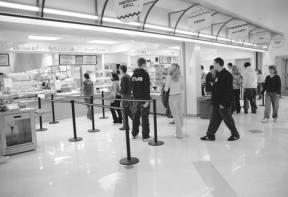Reacting to food fights during lunch Sept. 3, South Whidbey High School split its lunch periods into two on Friday and Monday.
Students were back to a single lunch period on Tuesday.
A food fight, which was described by some students as being minor and involving only a few students, broke out Sept. 3.
In response Johnson scheduled a second, 30-minute lunch at 11:30 a.m. Adding the second lunch period cut into class time those two days.
Students wrote e-mails over the weekend protesting the split lunch and urging a boycott of hot lunch until the one period returned.
Some students were dismayed by having two lunches, saying it would affect their social life and would cause some students to miss out on lunchtime club activities.
But in the view of high school Principal Mike Johnson, splitting the lunch period was positive.
“Behavior has improved,” he said. “Lunch room behavior will be evaluated over the next two terms for violations. We want to ensure the safety of our students.”
Monday’s first lunch proceeded quietly with a few students buying hot lunch, while others sat at tables eating cold lunch.
Normally the hot lunch line is long and winds out the door into the courtyard. The few students who passed through the lunch line summed up their decision simply by saying they were hungry and didn’t bring anything from home.
Others were more adamant and determined. Juniors Shawn VonPressentin, Michael Downey and Jimmy Adams said they would boycott hot lunch for as long as it takes the administration to change the schedule back to one lunch. As it turns out, that change only took until Tuesday.
The district’s lunch program was the subject of a 46-page evaluation developed last spring by Gene White, a former consultant with Office of Superintendent of Public Instruction.
The study found that the 30-minute lunch period is inadequate for serving the 700 or so enrolled students as evidenced by overcrowding. Only about 17 percent of the high school population buys lunch.
Two lunches was suggested as a means of increasing hot lunch participation at the high school.
High school staff, administration and the site council overwhelming support one lunch.



